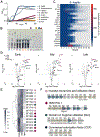A bacterial sialidase mediates early-life colonization by a pioneering gut commensal
- PMID: 38228143
- PMCID: PMC10922750
- DOI: 10.1016/j.chom.2023.12.014
A bacterial sialidase mediates early-life colonization by a pioneering gut commensal
Abstract
The early microbial colonization of the gastrointestinal tract can have long-term impacts on development and health. Keystone species, including Bacteroides spp., are prominent in early life and play crucial roles in maintaining the structure of the intestinal ecosystem. However, the process by which a resilient community is curated during early life remains inadequately understood. Here, we show that a single sialidase, NanH, in Bacteroides fragilis mediates stable occupancy of the intestinal mucosa in early life and regulates a commensal colonization program. This program is triggered by sialylated glycans, including those found in human milk oligosaccharides and intestinal mucus. NanH is required for vertical transmission from dams to pups and promotes B. fragilis dominance during early life. Furthermore, NanH facilitates commensal resilience and recovery after antibiotic treatment in a defined microbial community. Collectively, our study reveals a co-evolutionary mechanism between the host and microbiota mediated through host-derived glycans to promote stable colonization.
Keywords: commensal colonization; early-life microbiome; host-microbe interactions; human milk oligosaccharides.
Copyright © 2023 Elsevier Inc. All rights reserved.
Conflict of interest statement
Declaration of interests The authors declare no competing interests.
Figures




Update of
-
A bacterial sialidase mediates early life colonization by a pioneering gut commensal.bioRxiv [Preprint]. 2023 Aug 9:2023.08.08.552477. doi: 10.1101/2023.08.08.552477. bioRxiv. 2023. Update in: Cell Host Microbe. 2024 Feb 14;32(2):181-190.e9. doi: 10.1016/j.chom.2023.12.014. PMID: 37609270 Free PMC article. Updated. Preprint.
References
-
- Lou YC, Olm MR, Diamond S, Crits-Christoph A, Firek BA, Baker R, Morowitz MJ, and Banfield JF (2021). Infant gut strain persistence is associated with maternal origin, phylogeny, and traits including surface adhesion and iron acquisition. Cell Reports Medicine 2, 100393. 10.1016/j.xcrm.2021.100393. - DOI - PMC - PubMed
MeSH terms
Substances
Grants and funding
LinkOut - more resources
Full Text Sources
Molecular Biology Databases
Research Materials
Miscellaneous

